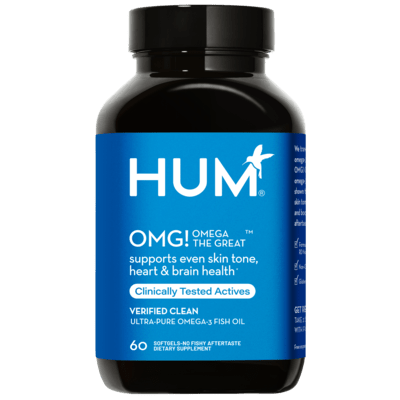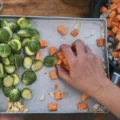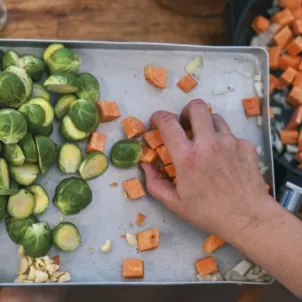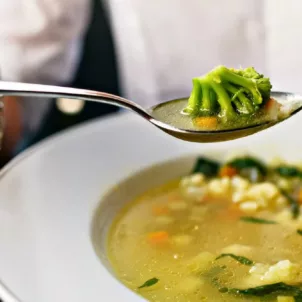The Best Foods for Detox for When You Need An Extra Kickstart
Searching for the best detox foods? Chelsey Amer, RDN, CDN, explains what “detox” really means—and shares her favorite ingredients and the best foods for a cleanse.
Here’s the truth: Most traditional detox or “cleanse” diets usually backfire. The majority—whether a strict eating plan or pre-packaged meals—drastically cut calories and nutrients, resulting in an under-nourished body, not a healthier one. You may lose some water weight, but that’s not sustainable weight loss. Instead of following a long list of foods you shouldn’t eat, remember your body has the ability to detox itself. No matter what you ate recently, a restrictive detox isn’t necessary. At HUM, we’re redefining what it means to detox by focusing on aiding your body’s natural detoxification processes through sound nutrition and supplementation. That’s right: While your body detoxes itself, foods can help give your system a boost. Read on to find out the best detox foods, according to an RD.
How Does the Body Detox Itself?
Your body is equipped with a liver, kidneys, digestive system, lymphatic system, and even your skin to help it “detox” daily. For instance, your kidneys filter 200 liters of blood per day to eliminate waste via urine. Your liver is the largest detoxification organ in your body that eliminates environmental toxins, as well as food additives, hormones, and more. Even your skin rids your body of waste through sweat.
Why Your Body Craves Detoxifying Foods

Whether you’ve gone on vacation, celebrated the holiday season, or have partaken in a bit of stress eating (you’re not alone), it’s natural to feel a tad more sluggish than normal. While you may welcome a break from your routine, it doesn’t always support your digestion levels. (Especially if you’re more lax with your supplement routine!)
Now is the time to listen to what your body is asking for. After a period of more indulgent eating, your body likely craves foods that naturally detox it. This doesn’t mean you need a formal detox plan or “cleanse” diet to get back on track. Rather, you should focus on adding more detoxifying foods to your meals to help you feel your best in a sustainable way.
How Long Should a Natural Detox Last?
Since your body is already an expert at detoxification on its own, it may just need a little boost of support from a well-balanced diet that includes detox foods and ingredients. Adding these to your meal plan will help support your natural detoxification pathways.
Remember: Your diet never has to take an all-or-nothing approach. You can enjoy your favorite foods *and* detox foods on the same day. As a registered dietitian, I suggest keeping a food journal to note how you feel from the foods you eat. After several days of eating more detoxifying foods, like those mentioned below, you will start to feel better: your energy levels will be elevated, and you’ll sleep more soundly.
The 12 Best Detox Foods

Instead of trying the latest juice cleanse this new year, try to include more of these 12 foods in your diet. By focusing on addition versus subtraction, you’re less likely to feel deprived.
1. Chlorella and Spirulina
Chlorella and spirulina are the ultimate green superfood duo. Both greens are types of algae, so you’ll typically find them in the form of a dried powder or capsule. They’re high in antioxidants, which help to protect your body from oxidative damage. Both algae are also packed with an impressive amount of vitamins and minerals. For instance, chlorella packs 202 percent DV of iron per ounce, while an ounce of spirulina has 85 percent DV of copper.
Perhaps most impressive are their combined detoxification powers. Spirulina supports normal function of the liver and kidneys, which are major organs for detoxification, while chlorella may help enhance the body’s natural ability to remove impurities. Chlorella and spirulina are the main ingredients in HUM’s Daily Cleanse, which is an easy way to get your fix of the powerful greens.
2. Beets
The deep purple hue of beets indicates their rich antioxidant content. But even more, beets contain a compound called betaine. Betaine fights inflammation and helps support liver function, eliminating toxins and supporting proper metabolism. That’s one reason you’ll find beet root powder in HUM’s Daily Cleanse.
Further, beets are a potent source of nitrates, which can help improve blood flow and even help your muscles work more efficiently. In fact, a study found that trained athletes who drank beetroot juice experienced improved performance.
Beets make a great addition to salads or grain bowls. You can even buy pre-steamed beets to “beat” the mess that red beets can cause in the kitchen!
3. Broccoli
Broccoli is one of the most popular vegetables for good reason: It’s affordable, easy to find in the supermarket, and packed with nutrients. But did you know it also supports your body’s natural detox pathways? Thanks to its rich fiber content (one cup of broccoli florets contains nearly 10 percent of your daily fiber needs), broccoli helps eliminate waste from the digestive tract.
Broccoli is also packed with antioxidants to scavenge free radicals, compounds that can cause inflammation in the body. Specifically, broccoli contains glucosinolates, a compound that produces the enzyme glutathione, which is necessary for many liver detoxification pathways. If that weren’t enough, broccoli is also an excellent source of vitamin C, another antioxidant that helps eliminate toxins from the body.
When it comes to preparation, broccoli is also extremely versatile. You can enjoy broccoli raw from a crudite plate ( with a delicious dip, like guacamole) or roast it to serve alongside baked salmon for a meal full of detoxifying foods.
4. Green Tea
The best detox drink is green tea. It’s packed with antioxidants, specifically catechins, which are known to help neutralize free radicals. You’ll find matcha green tea powder in HUM’s Daily Cleanse, making it easy to get your daily dose. Catechins are even shown to boost immune function too. If you’re feeling run down, your body can use the extra support and hydration from green tea.
Psst: Did you know that green tea is also good for your skin? Try replacing your afternoon cup of coffee with green tea instead for glowing, radiant skin (and a happy, healthy gut).
5. Sauerkraut
Another one of the best detox foods to eat? Sauerkraut. Sauerkraut is fermented cabbage with a sour and salty taste. While you may traditionally think of sauerkraut as a staple hot dog topping (and it is), it’s also full of probiotics to help support your gut health, as well as vitamins, minerals, and antioxidants too. Even more, cabbage is rich in sulforaphane, a sulfur-containing compound that’s been found to have far-reaching health benefits (such as neutralizing free radicals and decreasing inflammation, for example).
Your gut is home to over 70 percent of your immune system, so keeping it well-functioning is key to feeling your best, especially during cold and flu season. To aid detoxification pathways in your body, your gut should be populated with good bacteria for optimal digestion. Eating more probiotic-rich foods, like sauerkraut, is a great way to enhance your gut health.
While chowing down on hot dogs may not be the best choice, you can still include sauerkraut in your diet by adding it to grain bowls, salads, sandwiches, or snacking on a forkful at a time (don’t knock it ‘til you try it!).
6. Artichokes
Artichokes may not be the most popular veggie in the produce aisle, but you should still consider adding them to your shopping list. Not only do they have impressive prebiotic fiber content, but they also contain nutrients that help support bile production in the liver. Prebiotics are essentially food for the probiotics (good bacteria) in your gut. As we know, a healthy gut is essential for proper detoxification to occur in your body. Furthermore, artichokes help support digestion because bile helps your body digest fats.
If steaming a whole artichoke is intimidating to you, try buying frozen or canned quartered artichoke hearts. They’re still packed with the health-boosting nutrients you should add to your diet. Pro tip: Artichoke hearts are a great addition to any salad, pasta dish, or antipasto plate you create.
7. Avocado
Everyone loves guacamole… and for a good reason! Avocados are nutritional powerhouses with dozens of vitamins and minerals to help support your health. Plus, since they’re rich in healthy fats, avocados will keep you full for hours, making them a great addition to salads, stir fry, and tacos.
But did you know that avocados are also a source of glutathione, like broccoli, which helps detoxify the liver? Plus, just half of a medium avocado contains 6.5 grams of fiber, which is over 25 percent of your daily fiber needs. Remember, it’s recommended that women and men consume 25-35 grams of fiber per day, respectively, to keep your gut microbiome happy and healthy. Try this avocado gazpacho or this chocolate avocado mousse for new ways to enjoy avocado.
8. Salmon
Salmon is one of the best detox foods because it’s rich in omega-3 fatty acids, which are important for the health of your brain, heart, mood, sleep quality, and more. Omega-3 fatty acids are considered essential fatty acids because your body cannot make them on its own. They help reduce inflammation and are an integral component of cell membranes throughout your body.
Most Americans consume much more inflammatory omega-6 fatty acids compared to omega-3 fatty acids. To help improve this ratio, we suggest focusing on your omega-3 fatty acid intake. Aim to consume fatty fish, like salmon, at least twice weekly. Further, include other sources of omega-3s in your diet, including walnuts and flaxseeds. You can also take supplemental omega-3 fish oil, like HUM’s OMG! Omega The Great, which packs your daily dose of omega-3 fatty acids.

9. Chia Seeds
Chia seeds are a great detoxifying food, thanks to their many health benefits. They’re a potent source of fiber, with a whopping 10 grams of fiber per ounce serving. In addition to water, fiber is essential to keep your digestive tract moving and for regular bowel movements. Further, fiber feeds the healthy bacteria in your gut, so it’s necessary for optimal digestive health.
Chia seeds also contain plant-based protein and heart-healthy omega-3 fatty acids, which research shows can help reduce inflammation in your body.
Despite what you read online, you don’t have to drink “chia water” (known as the internal shower on TikTok) to get the detoxifying benefits. Create a delicious chia pudding for breakfast, sprinkle them on a salad for lunch, or use them to bake muffins as a snack or dessert.
10. Wild Blueberries
Although small in size, blueberries are mighty in their antioxidant content—specifically anthocyanin. According to research, anthocyanin gives blueberries their deep blue hue and helps neutralize free radicals, which contribute to many chronic diseases. In terms of detoxification, blueberries are rich in fiber, helping support gut health. Fiber binds to toxins and waste in the digestive tract ensuring they’re not reabsorbed into the bloodstream.
Blueberries are delicious by the handful, but I suggest stocking up on frozen wild blueberries, which have even more anthocyanins than traditional blueberries, to add to oatmeal bowls or smoothies. Try this detoxifying smoothie recipe for a filling snack, balanced with fiber and healthy fats.
11. Cucumbers
Cucumbers are extremely hydrating, which is key for supporting your body’s natural detoxification pathways. Consuming enough water helps keep everything moving through your body (read: through your digestive system and bowels). This helps to eliminate toxins and waste so that you can beat any unwelcome bloat. In addition to their nourishing water content, cucumbers also contain fiber—which helps to keep you regular and eliminate waste from your body.
Cucumbers are versatile: You can add them to your salads and grain bowls—or you can snack on them with hummus (or alone).
12. Sweet Potatoes
Last on the list of detoxifying foods is sweet potatoes. These orange-hued potatoes are rich in vitamin A, fiber, and potassium, which makes them an excellent choice to support your immune health, digestive health, and even help flush out excess water from your body. More specifically, sweet potatoes contain phytochelatins, which can bind heavy metals, further detoxing your body.
Restrictive diets can lead to overeating and binge eating at a later moment, so including whole foods, including carbohydrates like sweet potatoes, is important while focusing on detoxifying foods. Roast a batch of cubed sweet potatoes tossed in olive oil, salt, and pepper at 375°F for about 20-25 minutes until evenly browned to add to salads, grain bowls, and more.
Sample Detox Foods Menu
Here’s a sample menu that includes the best detox foods listed above:

Breakfast: Chia seed pudding with HUM’s Core Strength Protein Powder topped with Blueberries
Lunch: Large salad with chickpeas, artichokes, sweet potatoes, avocado, and sauerkraut
Snack: Vitamin C-rich smoothie
Dinner: Sheet Pan Roasted Salmon with broccoli and beets plus a cup of green tea
Dessert: Avocado chocolate mousse
Try including more of these 12 detoxifying foods in your diet for at least a week to see how you feel.
Other Ways to Help Detox Your Body

Furthermore, you can support your body’s natural detoxification pathways based on what you eat, your digestive health, sleep quality, daily movement, and more. For instance, you may wish to limit your alcohol intake after weeks of higher intake throughout the holiday season. Your liver metabolizes most alcohol you consume, so limiting alcohol intake gives your liver a rest. By optimizing your body’s systems you can improve your energy levels and get back to feeling like yourself ASAP.
In addition to adding more detoxifying foods to your diet, be sure to prioritize:
- High-quality sleep: Experts suggest seven to nine hours of sleep per night. Shut off blue light devices about an hour before bed.
- Digestive health: Include more prebiotic- and probiotic-rich foods
- Daily movement: Aim to move your body daily in a way that feels best for you. Some days this may include going for gentle walks and yoga, whereas others will include more vigorous strength training, spinning, or high-intensity exercise.
- Supplement routine: Examine your supplement regimen to see where you may need to tweak it. Reach out to your HUM RD with questions and concerns.












